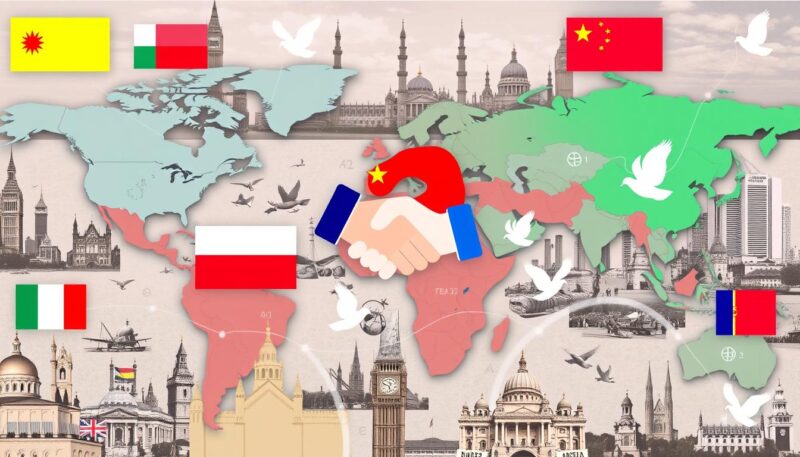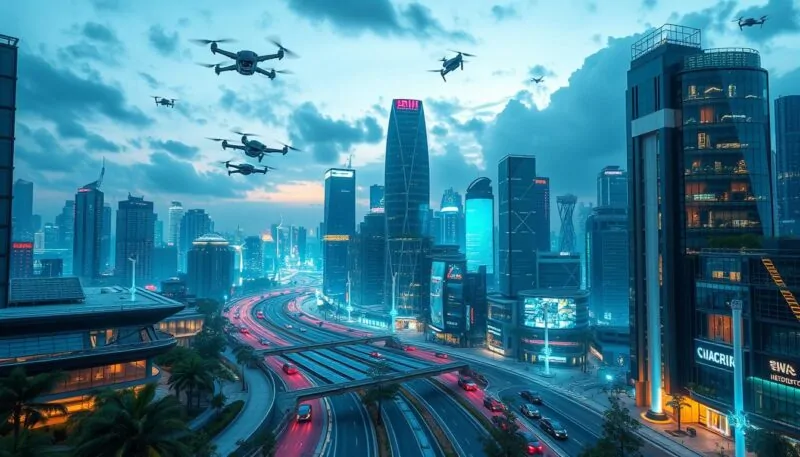
Share Post:
Have you ever wondered what defines the current epoch in historical terms? The period we live in today is often referred to as contemporary history, which extends from about 1945 to the present day. This era, beginning right after the conclusion of World War II, encompasses immense changes in global politics, society, and technology.
Understanding contemporary history provides valuable insights into how the world has evolved from the aftermath of a global conflict to the complex, interconnected society we know today. This historical analysis helps you appreciate the significant political shifts, economic changes, and developments in international relations that shaped the modern history landscape.
Table of Contents
ToggleKey Takeaways
- Contemporary history spans from the end of World War II in 1945 to the present day.
- The Cold War, running from 1947 to 1991, is a critical phase in this period.
- Decolonization between 1945 and 1975 led to the rise of new nations across Asia, Africa, and the Middle East.
- Supranational organizations like the United Nations and the European Union emerged post-1945.
- Technological advancements and economic booms transformed global living standards in the developed world.
The Definition of Contemporary History
The concept of contemporary history is intrinsically tied to the post-1945 era, a period marked by a plethora of significant global developments. This definition encompasses the extensive array of events and shifts that have shaped the modern world as we know it today. Academic study in this field aims to provide insight into this transformative period.
Timeframe: Post-1945 to Present
The timeframe for contemporary history begins with the end of World War II and extends to the present day. This era is characterized by the aftermath of the war, which set the stage for remarkable political, economic, and social changes. The Cold War era brought about a tense geopolitical landscape, with major conflicts influencing international relations.
Overlap with Modern History
While contemporary history is considered a subset of modern history, the distinction lies in its focus. Modern history spans several centuries, whereas contemporary history zeroes in on post-1945 events. The academic study of contemporary history often intersects with that of modern history, as the ramifications of earlier centuries still resonate in the post-1945 era.
Relation to Postmodernity
The evolution of society into postmodernity is a key feature of contemporary history. This period marks a departure from traditional institutions and ideologies, embracing pluralism and questioning established narratives. The era’s major conflicts and the intensification of communication significantly influenced the cultural landscape, aligning well with postmodernity.
| Institutions | Establishment Year | Focus |
|---|---|---|
| Institute of Contemporary British History (now Centre for Contemporary British History) | 1986 | Academic study of recent British history |
| Deutsches Institut für Zeitgeschichte (IfZ) | 1949 | Study of recent German history, particularly the Nazi period |
What is Contemporary History?
Contemporary history is an academic discipline within the broader field of modern history, focusing on events and circumstances that still influence our current world. This study typically encompasses the post-1945 era, examining pivotal developments that have shaped global and societal structures. Universities like the University of Nottingham have dedicated extensive resources towards this field, exploring themes from British foreign policy in the Middle East to social change and de-industrialization in postwar Britain.
Key research projects in the contemporary history domain include the exploration of China Ports, the political culture of Chinese communism, and the impact of fertility policies in Apartheid South Africa. By integrating insights from disciplines such as political science, sociology, and anthropology, expert historical insight into contemporary history provides a comprehensive understanding of the forces that molded the post-1945 era.
The focus on contemporary history extends beyond national perspectives, addressing international issues such as nation-building and refugee rehabilitation in post-partition India and social change in the U.S. during the 1970s. This level of depth ensures that the study of contemporary history not only highlights prominent historical transitions but also elucidates how current issues are echoes of past events.
The establishment of centers like the Institute of Contemporary British History in 1986 marks the evolution and significance of contemporary history. Reflective of the global trend, similar institutions have emerged across Europe, emphasizing not just the historical trajectories but also the methodologies employed to study the recent past. Techniques such as oral history and access to expansive electronic archives have revolutionized our approach, offering valuable perspectives and concrete data that enrich the understanding of modern history.
Expert historical insight into contemporary history allows us to contextualize critical occurrences and policies, forming a bridge to comprehend current international dynamics. As an interdisciplinary study, it seeks to capture and interpret the transformation of power relationships, cultural movements, and evolving norms, painting a comprehensive picture of the modern history era.
Major Political Shifts and Key Events
The landscape of international relations has been heavily influenced by significant political shifts and key events. One of the major events that shaped contemporary political history is the Cold War. This period, spanning from 1947 to 1991, was characterized by ideological conflict between the United States and the Soviet Union, leading to proxy wars, interventions in smaller nations, and heightened nuclear tensions. The end of the Cold War saw a wave of democratization in Europe, Africa, and Latin America, reshaping many political frameworks.

The Cold War and its Aftermath
The Cold War’s aftermath included the emergence of new political realities and challenges in international relations. The dissolution of the Soviet Union in 1991 signaled the end of the bipolar world order and ushered in an era of American dominance. The geopolitical landscape saw the revival of democracies in former communist states and the emergence of new international players.
Decolonization and the Rise of New Nations
The mid-20th century also witnessed a significant political shift through decolonization. This movement led to the independence of numerous countries in Southeast Asia, the Middle East, and Africa. The rise of these new nations altered the geopolitical landscape, giving voice to previously marginalized regions in international forums and impacting global political history.
Impact of the United Nations and European Union
Two significant political organizations that emerged in the post-World War II era are the United Nations and the European Union. The United Nations has played a crucial role in promoting peace, security, and international cooperation. Similarly, the European Union has been fundamental in fostering economic integration and political stability within Europe. Both organizations have significantly influenced international relations, marking a shift towards more cooperative and collaborative global governance structures.
Overall, these major political shifts and events have left lasting impacts on contemporary political history and altered the course of international relations significantly.
Economic Changes and Globalization
The aftermath of World War II sparked a period of significant economic changes and the rapid rise of globalization. This era, known as the post-war economic boom, catapulted several nations into new economic powers, reshaping global trade dynamics and market integration.
The Post-War Economic Boom
Following World War II, the United States and other developed nations experienced a dramatic surge in economic growth. This post-war economic boom facilitated an unprecedented rise in living standards, highlighted by the spread of Western culture and technological advancements.
Countries like Japan and West Germany, heavily impacted by the war, rebounded to become economic powerhouses. The economic resurgence in these regions was fueled by rapid industrialization and innovation.
Not only did this period benefit established economies, but it also paved the way for the emergence of new economic powers. The Four Asian Tigers—Hong Kong, Singapore, South Korea, and Taiwan—exemplify this transformation as they transitioned from developing economies to leading global financial centers.
Globalization and New Economic Powers
The dramatic swing towards globalization marked the integration of international markets and opened new economic frontiers for many countries. Noteworthy examples include China and Vietnam, which experienced an increased standard of living due to their integration into global trade networks.
However, globalization’s impact has not been uniformly positive. For instance, Africa has not reaped the same benefits as Asia and Latin America due to persistent political and economic instability. Additionally, the garment industry in Bangladesh, employing millions, faces significant challenges such as low wages and poor working conditions.
In the context of production, the automotive industry clearly illustrates the influence of globalization, with different car components manufactured in various countries. Furthermore, the outsourcing of services and manufacturing operations to nations like India and Mexico highlights how globalization seeks cost efficiencies while impacting local labor markets.
Despite the many benefits associated with globalization, it has also led to increased income disparity and declining wages for unskilled workers. Issues like child labor and labor exploitation in countries lacking sufficient protections underscore the complexities and often controversial nature of globalization.
In summary, economic changes and globalization have ushered in new economic powers and opportunities while presenting considerable challenges that continue to shape the modern economic landscape.
Technological Advancements
Understanding contemporary history involves delving into the technological advancements that have significantly transformed our world since 1945. From the birth of the Information Age to breakthroughs in science and medicine, and monumental achievements in space exploration, each facet has played a pivotal role in shaping modern society.
The Information Age
The dawn of the Information Age marked an era where computers and the Internet revolutionized how humans communicate and process information. This period has seen the development of nuclear technology, semiconductors, and quantum field theory, each significantly impacting various sectors. Advances in digital technology have undoubtedly redefined interactions in society and led to the creation of new markets and industries.
Advances in Science and Medicine
Technological advancements in science and medicine have been instrumental in extending human lifespan and improving quality of life. Progress in molecular biology and genetics has led to groundbreaking treatments and medical interventions. These improvements have been driven by the symbiotic relationship between technological development and societal needs, leading to medical breakthroughs that were once unimaginable.
Space Exploration
Space exploration stands as one of the most fascinating areas of technological advancements. This venture into the cosmos has expanded our understanding of the universe and our place within it. Achievements such as the moon landing, Mars rovers, and the International Space Station have pushed the boundaries of human capability. The impact of space exploration transcends science, influencing culture, politics, and international collaborations.

| Sector | Key Innovations | Impact |
|---|---|---|
| Information Age | Computers, Internet, Semiconductors | Revolutionized communication and industry |
| Science and Medicine | Molecular Biology, Genetics, New Treatments | Extended human lifespan, improved quality of life |
| Space Exploration | Moon Landing, Mars Rovers, ISS | Expanded knowledge of the cosmos, influenced global cooperation |
The intricate journey of technological advancements in the Information Age, breakthroughs in science and medicine, and the relentless pursuit of space exploration showcase the profound impact of these developments on contemporary history. These strides are a testament to human ingenuity and the unyielding quest for progress.
Conclusion
In examining contemporary history, the post-1945 era unveils a transformative journey that has continually molded our present world. Reflecting on the major political shifts, the economic boom, and unprecedented technological progress highlights how these key events have reshaped societies and economies globally. The transition from a unipolar world dominated by the West to a more multipolar landscape, prominently with the rise of Asia, has been pivotal in defining modern geopolitics and economic dynamics.
Key moments such as the Cuban Missile Crisis, the Vietnam War, the rise of communism in China and Eastern Europe, and the subsequent fall of the Soviet Union signaled significant political shifts. Similarly, periods of economic prosperity and crises, including the post-war economic boom and the Asian financial crisis, underlined the complexity and interconnectedness of global economies. The narrative of decolonization in Africa and Asia captures the emergence of new nations striving for self-determination, further reflecting the changing tides of global power.
Technological advancements have played a crucial role in shaping contemporary history. From the dawn of the Information Age to breakthroughs in science and space exploration, these innovations have redefined communication, healthcare, and our understanding of the universe. As you navigate through the intricate fabric of the post-1945 era, it’s clear that contemporary history provides invaluable insights into current global trends and future trajectories. This era instructively punctuates the continuous evolution of humanity through its political, economic, and technological milestones.
Source Links
- https://en.wikipedia.org/wiki/Contemporary_history
- https://education.cfr.org/learn/contemporary-history-0
- https://archives.history.ac.uk/makinghistory/resources/articles/contemporary_history.html
- https://www.cpalms.org/PreviewCourse/Preview/667
- https://www.theatlantic.com/magazine/archive/1967/03/on-the-writing-of-contemporary-history/305731/
- https://www.nottingham.ac.uk/humanities/departments/history/research/research-themes/contemporary-history.aspx
- https://www.pewresearch.org/politics/2016/12/15/americans-name-the-10-most-significant-historic-events-of-their-lifetimes/
- https://en.wikipedia.org/wiki/Political_eras_of_the_United_States
- https://www.history.com/topics/black-history/civil-rights-movement
- https://education.nationalgeographic.org/resource/effects-economic-globalization
- https://www.cambridge.org/core/journals/journal-of-economic-history/article/economic-history-and-contemporary-challenges-to-globalization/616A2B63EDFDE212193C324157498179
- https://www.historyoftechnology.org/publications/historical-perspectives-on-technology-culture-and-society/
- https://www.britannica.com/technology/history-of-technology
- https://en.wikipedia.org/wiki/History_of_technology
- https://www.worldhistory.biz/contemporary-history.html
- https://marxists.architexturez.net/archive/dutt/1963/contemporary-history.htm






